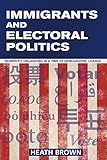Immigrants and Electoral Politics : Nonprofit Organizing in a Time of Demographic Change / Heath Brown.
Material type: TextPublisher: Ithaca, NY : Cornell University Press, [2016]Copyright date: ©2016Description: 1 online resource (248 p.) : 2 line figures, 14 tables, 8 chartsContent type:
TextPublisher: Ithaca, NY : Cornell University Press, [2016]Copyright date: ©2016Description: 1 online resource (248 p.) : 2 line figures, 14 tables, 8 chartsContent type: - 9781501705922
- Community organization -- United States
- Community organization; United States
- Elections -- United States
- Elections; United States
- Immigrants -- Political activity -- United States
- Immigrants -- Services for -- United States
- Immigrants; Political activity; United States
- Immigrants; Services for; United States
- Nonprofit organizations -- Political activity -- United States
- Nonprofit organizations; Political activity; United States
- Political participation -- United States
- Political participation; United States
- Business (General)
- Discrimination & Race Relations
- Political Science & Political History
- POLITICAL SCIENCE / Political Process / Campaigns & Elections
- immigrants, immigrant communities, nonprofit voter mobilization, organizational response, hate crimes
- 324.9730086912 23
- JV6477 .B76 2017
- online - DeGruyter
| Item type | Current library | Call number | URL | Status | Notes | Barcode | |
|---|---|---|---|---|---|---|---|
 eBook
eBook
|
Biblioteca "Angelicum" Pont. Univ. S.Tommaso d'Aquino Nuvola online | online - DeGruyter (Browse shelf(Opens below)) | Online access | Not for loan (Accesso limitato) | Accesso per gli utenti autorizzati / Access for authorized users | (dgr)9781501705922 |
Browsing Biblioteca "Angelicum" Pont. Univ. S.Tommaso d'Aquino shelves, Shelving location: Nuvola online Close shelf browser (Hides shelf browser)

|

|

|

|

|

|

|
||
| online - DeGruyter The Worker Center Handbook : A Practical Guide to Starting and Building the New Labor Movement / | online - DeGruyter Unclear Physics : Why Iraq and Libya Failed to Build Nuclear Weapons / | online - DeGruyter Staging Harmony : Music and Religious Change in Late Medieval and Early Modern English Drama / | online - DeGruyter Immigrants and Electoral Politics : Nonprofit Organizing in a Time of Demographic Change / | online - DeGruyter A Fight for the Soul of Public Education : The Story of the Chicago Teachers Strike / | online - DeGruyter Insider Threats / | online - DeGruyter Central Banks and Gold : How Tokyo, London, and New York Shaped the Modern World / |
Frontmatter -- Contents -- Acknowledgments -- Introduction: Political Variety and Electoral Efficacy of Immigrant Nonprofit Organizations -- 1. The Precarious Position of Immigrants -- 2. Foundations and Funding -- 3. “You Don’t Vote, You Don’t Count” -- 4. A Model of Immigrant-Serving Engagement -- 5. From Mission to Electoral Strategy -- 6. Choosing Where to Focus -- Conclusion: Boldly Representing Immigrants in Tough Times -- Technical Appendix -- Notes -- Works Cited -- Index
restricted access online access with authorization star
http://purl.org/coar/access_right/c_16ec
In Immigrants and Electoral Politics, Heath Brown shows why nonprofit electoral participation has emerged in relationship to new threats to immigrants, on one hand, and immigrant integration into U.S. society during a time of demographic change, on the other. Immigrants across the United States tend to register and vote at low rates, thereby limiting the political power of many of their communities. In an attempt to boost electoral participation through mobilization, some nonprofits adopt multifaceted political strategies including registering new voters, holding candidate forums, and phone banking to increase immigrant voter turnout. Other nonprofits opt to barely participate at all in electoral politics, preferring to advance the immigrant community by providing exclusively social services.Brown interviewed dozens of nonprofit leaders and surveyed hundreds of organizations. To capture the breadth of the immigrant experience, Brown selected organizations operating in traditional centers of immigration as well as new gateways for immigrants across the South: Florida, Illinois, Michigan, New Jersey, New York, and, North Carolina. The stories that emerge from his research include incredible successes in mobilizing immigrant communities, including organizations that registered sixty thousand new immigrant voters in New York. They also reveal efforts to suppress nonprofit voter mobilization in Florida and describe the organizational response to hate crimes directed at immigrants in Illinois.
Mode of access: Internet via World Wide Web.
In English.
Description based on online resource; title from PDF title page (publisher's Web site, viewed 26. Apr 2024)


